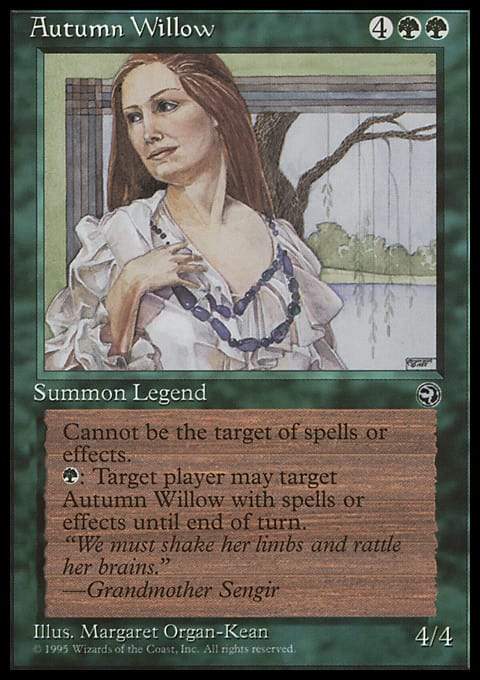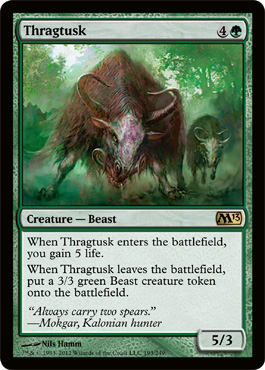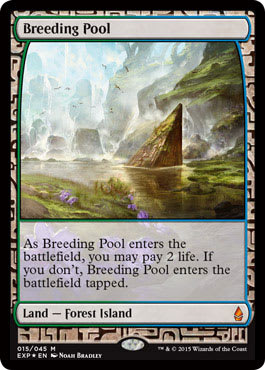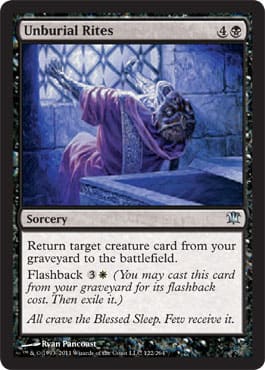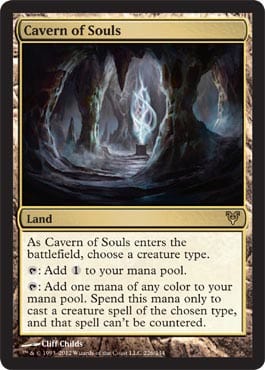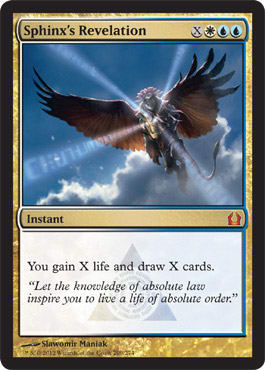Blue was clearly the best, followed by black (though Necropotence flipped that for a bit). White was good, mostly because of Swords to Plowshares, Disenchant, and Wrath of God and because it paired so well with blue. Red was mostly good as a standalone burn color, but it occasionally had powerful cards such as Wildfire or, um, Wildfire Emissary (that is, oddly enough, not a joke).
Green, on the other hand, was terrible.
The color was, by and large, unplayable for much of Magic’s early history. The odd G/W deck popped up here and there, but those were mostly Armageddon/Swords to Plowshares decks that happened to be able to take advantage of green’s mana creatures and random fatties such as Erhnam Djinn and Autumn Willow (how far we’ve come . . . ). Stompy was a thing, for a while, but by and large, green just wasn’t good. And everyone knew that.
Including Wizards. So they did something about it.
At first, the attempts were somewhat weak, but the real breakthrough for green came with Fifth Dawn and the printing of Eternal Witness. Wizards was making a conscious effort to improve green and did so by consciously pushing green cards. The last Regrowth update Wizards had printed—Elven Cache—was both 1 mana more and lacked the synergies Eternal Witness possessed.
Clearly, they were serious.
Things just kept growing better for green from there. Lorwyn block gave rise to the Elves. Shards of Alara brought us Wild Nacatl, Zendikar block Green Sun's Zenith, and so on and so forth. Current Standard called up Huntmaster of the Fells, Thragtusk, Loxodon Smiter, and Abrupt Decay.
Eventually, and with some work, green was good—very good.
On the other hand, a story very much the opposite of green’s could be told for blue.
Yes, Snapcaster Mage and Sphinx's Revelation exist. Yes, Delver of Secrets and Jace, the Mind Sculptor are both recent enough to scar our collective memories, but over the years, Wizards has tried to do to blue what it did to green in reverse: scaled back its most powerful mechanics.
And now, here we are. Blue is officially the worst color in Standard.
Don’t believe me?
Below are the breakouts of the number of decks in the Top 16s that had at least some cards of the appropriate color for the last three Standard Grands Prix plus the Pro Tour.
| Pro Tour: Gatecrash (just Top 8) | Quebec City | Rio de Janeiro | Verona |
|---|---|---|---|
| Green – 4 | Green – 13 | Green – 12 | Green – 11 |
| White – 6 | White – 7 | White – 8 | White – 9 |
| Blue – 4 | Blue – 1 | Blue – 2 | Blue – 4 |
| Black – 4 | Black – 13 | Black – 14 | Black – 10 |
| Red – 7 | Red – 15 | Red – 13 | Red – 15 |
The total number of blue decks in the Top 16 of all three Grands Prix combined (7) barely matches the second-least-represented color’s worst turnout in just one tournament (white in Quebec City).
Now let’s look at the last three StarCityGames Opens.
| Las Vegas | Indianapolis | Washington, DC |
|---|---|---|
| Green – 9 | Green – 12 | Green – 10 |
| White – 10 | White – 12 | White – 15 |
| Blue – 6 | Blue – 7 | Blue – 6 |
| Black – 5 | Black – 8 | Black – 12 |
| Red – 15 | Red – 8 | Red – 4 |
The pattern seems to be holding mostly true even at the triple-A level. We don’t hit the lows of Rio or Quebec City, but these are very Verona-like numbers.
Notice that even in Vegas, where R/W/U was the deck of the tournament—placing six copies in the Top 16—those were the only blue decks that did well. Indianapolis was pretty flat across the non-Selesnya colors, but calling Prime Speaker Bant a blue deck (it was the primary driver of blue decks in that tournament) is akin to calling Wolf Run Bant a red deck. We do it for the purposes of this analysis, but it’s a bit intellectually dishonest. Still, Breeding Pools don’t lie.
When we add up all seven of these tournaments for a total of a hundred four decks, this is what the breakdown looks like:
- Green – 71
- White – 67
- Blue – 30
- Black – 66
- Red – 77
Or for those of you who like percentages, of the hundred four decks that made Top 16 or better in those seven tournaments (Top 8 for the Pro Tour), the nonblue colors were each in at least 63% of all decks.
Blue? Just shy of 29%.
So what happened? Why is blue at what seems like an all-time low?
Doesn’t Play Well with Block Themes
Innistrad’s graveyard-centric mechanics aren’t really blue’s forte. Sure, it has a few ways to dump cards into the graveyard—Forbidden Alchemy, Chronic Flooding, Thought Scour—but so did every other color (except white). But even then, green’s options are better and faster. Mulch is insane, and Grisly Salvage digs deeper than anything else.
What it lacks, however, is a way to meaningfully interact with the graveyard. Black and white have Unburial Rites, white has Angel of Glory's Rise and Angel of Serenity, and red has Harvest Pyre and Faithless Looting. Green’s entrances into this category (Boneyard Wurm and Splinterfright) are pretty weak, but it makes up for it with the best enablers.
Blue has Snapcaster Mage, which, while obviously among the most powerful of those cards, is more about spells than graveyards.
Blue even lacks the graveyard hate others have. Black has Cremate, green Ground Seal, white Rest in Peace and Purify the Grave, and red has Ash Zealot. Blue has . . . the same access to Tormod's Crypt and Grafdigger's Cage as everyone else.
To make matters worse, one of Blue’s current strengths—milling with Jace, Memory Adept or Nephalia Drownyard—actually plays right into the hands of graveyard decks. It’s often quite awkward to have Drownyard up and active but not use it for fear of helping out your opponent, but it happens all the time.
Creatures Are at an All-Time High
It used to be there was reliably a creatureless or creature-light deck somewhere in the format. But Wizards has long been pushing the power level of creatures, and we seem to have reached something of a high-end for the collection of creatures currently in Standard.
Just look at this list of creatures that make up the upper echelon of Standard playables right now: Huntmaster of the Fells, Thragtusk, Restoration Angel, Geist of Saint Traft, Snapcaster Mage, Thundermaw Hellkite, Hellrider, Loxodon Smiter, Burning-Tree Emissary, Olivia Voldaren, Falkenrath Aristocrat, Champion of the Parish, Geralf's Messenger, Gravecrawler, Boros Reckoner, Angel of Serenity, and Thalia, Guardian of Thraben.
These aren’t just the best creatures in Standard, many of them are simply the best cards, period, in Standard.
I don’t have any way to measure this, but I would venture to guess that this many 4- and 5-star creatures (anyone remember Inquest’s ratings? Anyone?) haven’t been in Standard at the same time basically ever. Nearly every one of these has seen some play beyond Standard, and that’s without even considering Deathrite Shaman or Delver of Secrets, which are underplayed in Standard but format-defining in Legacy and Modern.
Now, forget for a moment that most of these are any color but blue (though that’s certainly relevant) and note that blue is the color least equipped to handle creatures.
Traditionally, bounce and counter has been blue’s best in-color strategy (more on that in a moment), but most of these creatures are good specifically because they’re good against that sort of attempt at control. Huntmaster leaves behind a 2/2, Thragtusk is specifically worded to leave behind a 3/3 even when it doesn’t die, Geist can’t be touched, many of the red ones have haste, and so on, and so on.
Moreover, counterspells, even the Essence Scatters of the world, are unreliable ways to deal with creatures. Not only are many of the most dangerous creatures able to come under spells like Cancel or Dissipate with ease, there’s also this gem:
Cavern of Souls was such a game changer that it might almost single-handedly be responsible for blue’s lack of significance right now. For example, Junk Reanimator is exactly the sort of deck Blue decks should be good against—midrange, several large spells it needs to resolve, no endgame outside of casting and resolving its spells—but instead, it is actually very good against blue decks thanks to Cavern making looping Angel of Serenity not only a possible plan, but a very real endgame.
Without Cavern of Souls, Dissipate punishes this line of play far too easily, and Essence Scatter would make it somewhat laughable. That’s not to say Cavern is a bad thing (that’s a whole other debate).
One of blue’s best weapons pre-M13 was, interestingly enough, Phantasmal Image. Why? Because it was often blue’s best answer to creatures. If you can’t beat them, join them. It’s one of the reasons I think Clone and Evil Twin should probably be seeing more play right now. There is, however, a huge difference between 2 mana and 4.
Card-Drawing Is Dead, Long Live Sphinx's Revelation!
Blue’s slate of card-drawing sucks right now.
“But, Blake,” you might say if you were a common article trope helping me out with this section, “Sphinx's Revelation is one of the best cards in Standard!”
That’s true, it is. But blue’s best card-drawing during its dominant years has always been of the 3- to 4-mana variety and rarely of the X-spell variety. Blue needs cheaper card-drawing to retain its place on top of the color pie. Cantrips like Thought Scour are nice and all, but blue’s strength, and the reason other colors paired with it so readily, was its ability to pluck multiple cards at once from the top of its library at discount prices.
Think Compulsive Research, Thirst for Knowledge, Fact or Fiction, and Careful Consideration. These days, 5 mana gets you Think Twice instead of Tidings, 3 mana gets you Divination instead of Jace Beleren, and Accumulated Knowledge is a far-distant memory.
One of the reasons Sphinx's Revelation is “so good” is that the first one, usually for 2 or 3, sets you up better for the second one for 4 or 5. Now imagine if your setup was Careful Consideration or Compulsive Research instead.
Yeah, exactly.
What’s a Blue Mage to Do?
Keep playing blue.
Seriously. While blue is at an all-time low, Wizards is pretty good about balancing these things out. Blue isn’t unplayably bad, it’s just the worst out of five. And there are always ways to reintroduce blue back into the conversation.
Take this deck by David McDarby at SCG Open: Washington, DC.
"David McDarby’s DC Open Deck"
- Creatures (9)
- 1 Evil Twin
- 3 Angel of Serenity
- 3 Augur of Bolas
- 1 Griselbrand
- 1 Obzedat, Ghost Council
- Planeswalkers (3)
- 3 Liliana of the Veil
- Spells (23)
- 1 Ultimate Price
- 3 Azorius Charm
- 4 Forbidden Alchemy
- 4 Thought Scour
- 3 Unburial Rites
- 4 Lingering Souls
- 4 Supreme Verdict
- Lands (25)
- 1 Swamp
- 2 Drowned Catacomb
- 2 Vault of the Archangel
- 4 Glacial Fortress
- 4 Godless Shrine
- 4 Hallowed Fountain
- 4 Isolated Chapel
- 4 Watery Grave
- Sideboard (15)
- 1 Obzedat, Ghost Council
- 1 Ultimate Price
- 1 Sundering Growth
- 2 Rhox Faithmender
- 2 Purify the Grave
- 1 Evil Twin
- 2 Dispel
- 2 Planar Cleansing
- 2 Negate
- 1 Pithing Needle
David, probably very much a blue mage, saw that Reanimator was a thing again and decided to swap out green’s enablers and swap in blue’s. The same could be done for a number of decks. Jund could be B/U/G or R/U/G (not so much Grixis), Humanimator could go back to Chronic Flooding, and Junk and Prime Speaker Bant are pretty close as it is.
Blue’s not dead. It’s just a bit green.
Random Things I’m Thinking
As always (and by “always,” I mean I’m making this a regular thing starting . . . now), I end with a few things I’m thinking.- Clone seems as though it could be a thing right now.
- Sorin, Lord of Innistrad is making a comeback.
- So is Lingering Souls.
- If Sports Night (the TV show) were to take place today, Ntazaki Nelson wouldn’t have been inspiring. He would have immediately been suspected of steroids.
- Would Assemble the Legion have caught on earlier if it wasn’t such an obvious pander to Johnnies and Timmies?
- Also, buy Assemble the Legion if you haven’t already.
- Duskmantle Seer. Still. Even more so. Nothing punishes Angel of Serenity and Craterhoof Behemoth more.
















